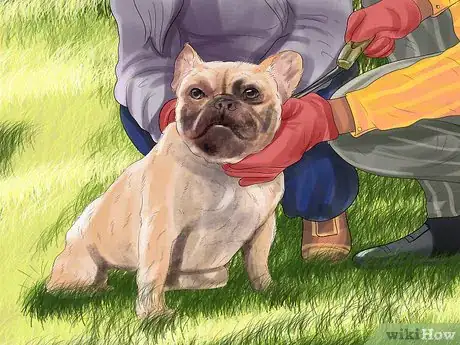This article was co-authored by Ryan Corrigan, LVT, VTS-EVN. Ryan Corrigan is a Licensed Veterinary Technician in California. She received her Bachelor of Science in Veterinary Technology from Purdue University in 2010. She is also a Member of the Academy of Equine Veterinary Nursing Technicians since 2011.
This article has been viewed 20,505 times.
If you own a female dog and are looking to breed her—whether for a business, to acquire a litter of puppies, or to sell the pups, you’ll need to select a suitable male for breeding. If you’re planning to maintain a pedigree, you’ll need to research the genetic history of the male dog. If you’re not concerned with pedigree, you may be more inclined to breed for specific physical or behavioral traits. Either way, take the male dog’s temperament into account, and make sure that the dog’s owners are amenable to the breeding process.
Steps
Deciding Whether or Not to Breed Your Female Dog
-
1Consider your reasoning for breeding your dog. Many inexperienced owners of female dogs do not consider the time commitment and responsibilities of breeding their dog, and may not fully think through the process. There are already plenty of puppies and breeders, and if you don’t find a suitable home for all of the puppies in your litter, they may wind up as stray animals or living in animal shelters.
- If you are only planning to breed your dog for the sake of having puppies for yourself, your children, or your friends: reconsider. There are plenty of other ways to get the fully puppy experience without breeding your dog.
- Also reconsider if you only want to breed a litter of puppies so that your dog can experience sex, so that your children can see what birth looks like, or to have another dog “just like” the female. None of these are sufficient reasons to breed your dog.
-
2Avoid harmful breeding practices. Many pedigreed dogs—especially those bred to be shown and to match the rigorous breed requirements established by specific show organizations or kennel clubs, including the World Canine Organization. Certain breeds—such as pugs and weimaraners—have been bred to match physical standards that leave the dogs with serious health problems in their adulthood. If you are breeding pedigreed animals together, make sure that the dogs’ offspring will still have functional bodies and be able to live comfortable lives.[1]
- Pugs have been bred to have large, bulging eyes, and they often suffer serious eye problems and eventual blindness.
- Weimaraners are bred to have broad, deep chests, but overbreeding for this feature often results in dogs with life-threatening gastric and intestinal conditions.
Advertisement -
3Research breeding practices. Breeding the dogs, delivering the litter, and raising the pups until they get adopted (around 8 weeks old) takes work, and will often occupy the majority of your time, even once the pups have been weaned. You will need to care for your dog while she gestates—about 63 days in most breeds—and take the dog to the vet for natal checkups.[2]
- Once your dog is pregnant, talk to your veterinarian about how you can prepare for the pregnancy and birthing processes.
- Your responsibilities as a breeder also extend to each puppy produced: you need to find each a safe, permanent home, whether there are 2 or 12 pups.
- Research as much as you can so that you are prepared and knowledgeable about your dog's pregnancy and delivery. If you can, try to meet with an experienced, ethical breeder to get some tips and inside information.
-
4Make sure you are logistically prepared for breeding. Finding a male and breeding the dogs requires logistics and planning, and raising a litter of pups for roughly 8 weeks requires financial commitment. Make sure your schedule, budget, and personal life will allow you to devote time and resources to the breeding, and
- You also need to be prepared ahead of time for unanticipated complications, such as the mother (your female dog) dying in the birthing process, or medical problems with one or more of the newborn pups.[3]
Breeding for Pedigreed Dogs
-
1Find a breeder. When breeding your dog, it’s smart to begin by looking for someone who owns a male dog of the same breed. Establishing trust with the owner of the male dog will give you the benefit of working with someone you trust, and will simplify the process of coordinating a stud fee and breeding logistics.[4]
- If you’re registered with the American Kennel Club (AKC), start there, as the AKC will be able to recommend viable breeders in your area. You may also be able to research pedigreed genetic lines and individual dogs online.
-
2Ask to see the male dog’s pedigree. This is a standard step when breeding two pedigreed dogs together, but one that cannot be overlooked. A pedigree will show the dog’s siblings, parents, grandparents, and in some cases, great-grandparents. For breeders of pedigreed dogs, it’s important to see this document, as it will indicate the legitimacy of a breeder’s claim to their dog’s pedigree, and point out any genetic incompatibilities between the two dogs.[5]
- In the United States, in order for pedigreed puppies to be registered with the AKC, they must be birthed by a pedigreed sire (father) and dam (mother).[6] AKC registration maintains records of pedigreed dogs and their offspring.
-
3Select a male who complements the flaws of your female. The male dog that you select to breed with your female needs to complement her genetic makeup. While both dogs should have strong pedigrees and genetic histories—without any serious medical issues—you should look for a male dog whose genetic and behavioral strengths can compensate for problem areas in your female, and vice versa.[7]
- For example, if your female has a thin coat of hair, select a male dog with a thick, appealing coat of hair.
Breeding Dogs without a Pedigree
-
1Watch the male dog’s behavior. Even if you’re not concerned about breeding for specific genetic traits, and not trying to maintain a bloodline, you should make sure that the male dog does not exhibit any concerning or unpleasant behaviors. These behaviors could be passed on to any pops that result from the litter, and result in them being unpleasant pets.
- For example, concerning behaviors in the male dog include: excessive anxiety or shyness when meeting new people, aggressive or temperamental behavior, separation anxiety, or hyperactivity.
- Of course, keep in mind that the dog behaviors will differ from one breed to the next. What is considered “abnormal” behavior for one breed may be fine in a different breed.
-
2Find out the male dog’s medical history. The male dog may bring medical problems to the union which could be passed on to the pups. Discuss the dog’s medical history with its owners. Ask if the dog has been screened for diseases that could be passed on genetically—if the dog hasn’t been, insist that the screening take place before the male dog and your female breed. If the male dog has Diseases with genetic components, find another mate for your dog.
- If the male dog’s owner has taken their animal to the vet regularly (which they should have), ask to peruse the veterinarian’s records. These will indicate if the dog has any serious or recurring problems that may be passed on to the pups.
- Ask specifically about diseases of common concern among pedigreed dogs, including hip and elbow dysplasia. These unfortunately common conditions are painful and affect many domesticated dogs.
-
3Communicate with the male dog’s owner. Once you decide on a breeder and a male dog to breed with your female, communicate regularly with the breeder, especially if they have had more experience breeding dogs than you. Ask if their dog—or its parents or grandparents—has a history of any genetic illnesses, or a disposition towards and problematic behaviors. Also ask if the breeder’s male corresponds with the “breed standard” (as established by the AKC).
- Before mating your female dog with the male dog you select, sign a legal agreement with the dog’s owners. This should specify the stud fee (a fee for the act of breeding), and specify the payment or number of puppies that the male dog’s owner will receive.[8]
-
4Plan ahead if crossbreeding. The practice of crossbreeding involves breeding together two different breeds of dog—whether intentionally or unintentionally. Crossbreeding is occasionally used as a deliberate practice, in order to introduce new genetic material and physical and behavioral traits into an overbred purebred bloodline, or to produce cute and well-behaved puppies.
- If crossbreeding your female with a male dog, be sensitive to the size difference. While the breeding itself may not be a problem, if the male is much larger than the female, the birthing process could be painful and potentially life-threatening.
References
- ↑ http://www.esdaw.eu/dog---breeding.html
- ↑ http://www.akc.org/dog-breeders/responsible-breeding/#commitment
- ↑ http://www.akc.org/dog-breeders/responsible-breeding/#commitment
- ↑ http://leerburg.com/pickpup.htm
- ↑ http://www.esdaw.eu/dog---breeding.html
- ↑ http://www.akc.org/dog-breeders/responsible-breeding/#mate
- ↑ http://www.akc.org/dog-breeders/responsible-breeding/#mate
- ↑ http://www.akc.org/dog-breeders/responsible-breeding/#contract
About This Article
To select a male dog for breeding, start by looking for someone who owns a male dog of the same breed as your female. If you’re registered with the American Kennel Club, ask them to recommend viable breeders in your area. When breeding 2 pedigree dogs, ask to see the male dog’s paperwork, which should include the dog’s siblings, parents, and grandparents. You’ll also want to pick a male who complements the flaws of your female. For example, if your female has a thin coat of hair, pick a male who has a thick coat of hair. When breeding dogs without a pedigree, pick a male dog who has a pleasant disposition and a clean medical history. Additionally, make sure the dogs are compatible if you’re crossbreeding. For example, if the male is much larger than the female, make sure she can safely deliver the pups. For more tips from our Veterinary co-author, including how to make sure you’re prepared for breeding dogs, keep reading!






































































